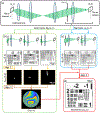Computational aberration compensation by coded-aperture-based correction of aberration obtained from optical Fourier coding and blur estimation
- PMID: 33134437
- PMCID: PMC7597901
- DOI: 10.1364/optica.6.000647
Computational aberration compensation by coded-aperture-based correction of aberration obtained from optical Fourier coding and blur estimation
Abstract
We report a novel generalized optical measurement system and computational approach to determine and correct aberrations in optical systems. The system consists of a computational imaging method capable of reconstructing an optical system's pupil function by adapting overlapped Fourier coding to an incoherent imaging modality. It recovers the high-resolution image latent in an aberrated image via deconvolution. The deconvolution is made robust to noise by using coded apertures to capture images. We term this method coded-aperture-based correction of aberration obtained from overlapped Fourier coding and blur estimation (CACAO-FB). It is well-suited for various imaging scenarios where aberration is present and where providing a spatially coherent illumination is very challenging or impossible. We report the demonstration of CACAO-FB with a variety of samples including an in vivo imaging experiment on the eye of a rhesus macaque to correct for its inherent aberration in the rendered retinal images. CACAO-FB ultimately allows for an aberrated imaging system to achieve diffraction-limited performance over a wide field of view by casting optical design complexity to computational algorithms in post-processing.
Figures
















Similar articles
-
Optical Aberration Calibration and Correction of Photographic System Based on Wavefront Coding.Sensors (Basel). 2021 Jun 10;21(12):4011. doi: 10.3390/s21124011. Sensors (Basel). 2021. PMID: 34200742 Free PMC article.
-
Wide field-of-view fluorescence image deconvolution with aberration-estimation from Fourier ptychography.Biomed Opt Express. 2016 Jan 7;7(2):352-68. doi: 10.1364/BOE.7.000352. eCollection 2016 Feb 1. Biomed Opt Express. 2016. PMID: 26977345 Free PMC article.
-
Wavefront-coding technique for inexpensive and robust retinal imaging.Opt Lett. 2014 Jul 1;39(13):3986-8. doi: 10.1364/OL.39.003986. Opt Lett. 2014. PMID: 24978788
-
Improved wavefront correction for coherent image restoration.Opt Express. 2017 Aug 7;25(16):18797-18816. doi: 10.1364/OE.25.018797. Opt Express. 2017. PMID: 29041073
-
Modeling human eye aberrations and their compensation for high-resolution retinal imaging.Optom Vis Sci. 1998 Nov;75(11):827-39. doi: 10.1097/00006324-199811000-00025. Optom Vis Sci. 1998. PMID: 9848838 Review.
Cited by
-
Raster adaptive optics for video rate aberration correction and large FOV multiphoton imaging.Biomed Opt Express. 2020 Jan 23;11(2):1032-1042. doi: 10.1364/BOE.377044. eCollection 2020 Feb 1. Biomed Opt Express. 2020. PMID: 32206400 Free PMC article.
-
Optical Aberration Calibration and Correction of Photographic System Based on Wavefront Coding.Sensors (Basel). 2021 Jun 10;21(12):4011. doi: 10.3390/s21124011. Sensors (Basel). 2021. PMID: 34200742 Free PMC article.
-
Computational single fundus image restoration techniques: a review.Front Ophthalmol (Lausanne). 2024 Jun 12;4:1332197. doi: 10.3389/fopht.2024.1332197. eCollection 2024. Front Ophthalmol (Lausanne). 2024. PMID: 38984141 Free PMC article.
-
Review of bio-optical imaging systems with a high space-bandwidth product.Adv Photonics. 2021 Jul;3(4):044001. doi: 10.1117/1.ap.3.4.044001. Epub 2021 Jun 26. Adv Photonics. 2021. PMID: 35178513 Free PMC article.
-
Fourier Ptychographic Microscopy via Alternating Direction Method of Multipliers.Cells. 2022 Apr 30;11(9):1512. doi: 10.3390/cells11091512. Cells. 2022. PMID: 35563818 Free PMC article.
References
-
- Lohmann AW, Dorsch RG, Mendlovic D, Zalevsky Z, and Ferreira C, “Space-bandwidth product of optical signals and systems,”J. Opt. Soc. Am. A 13, 470–473 (1996).
-
- Fried DL, “Anisoplanatism in adaptive optics,” J. Opt. Soc. Am 72, 52–61 (1982).
Grants and funding
LinkOut - more resources
Full Text Sources
Other Literature Sources
